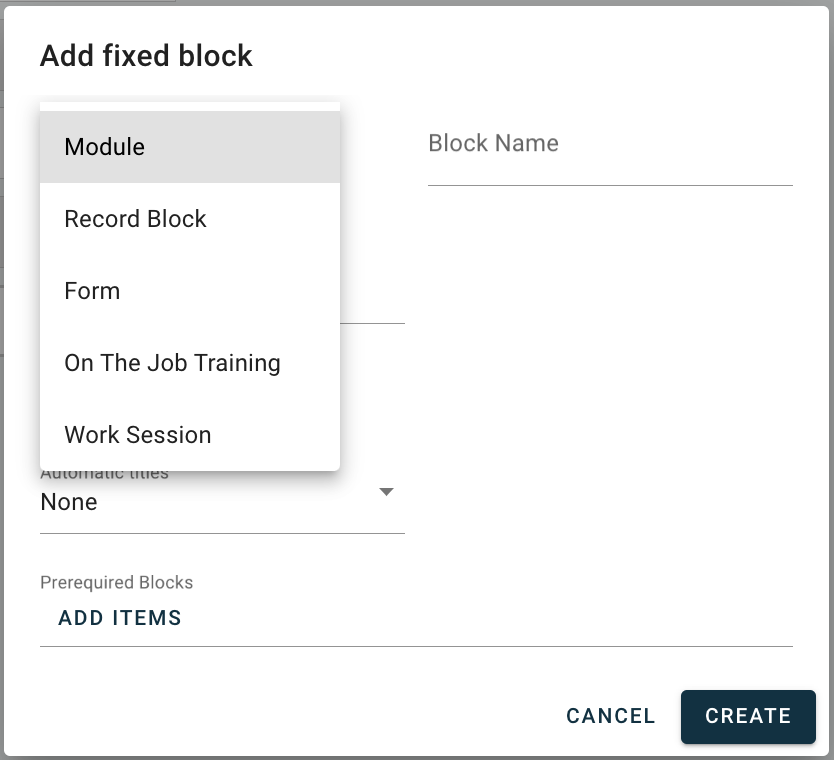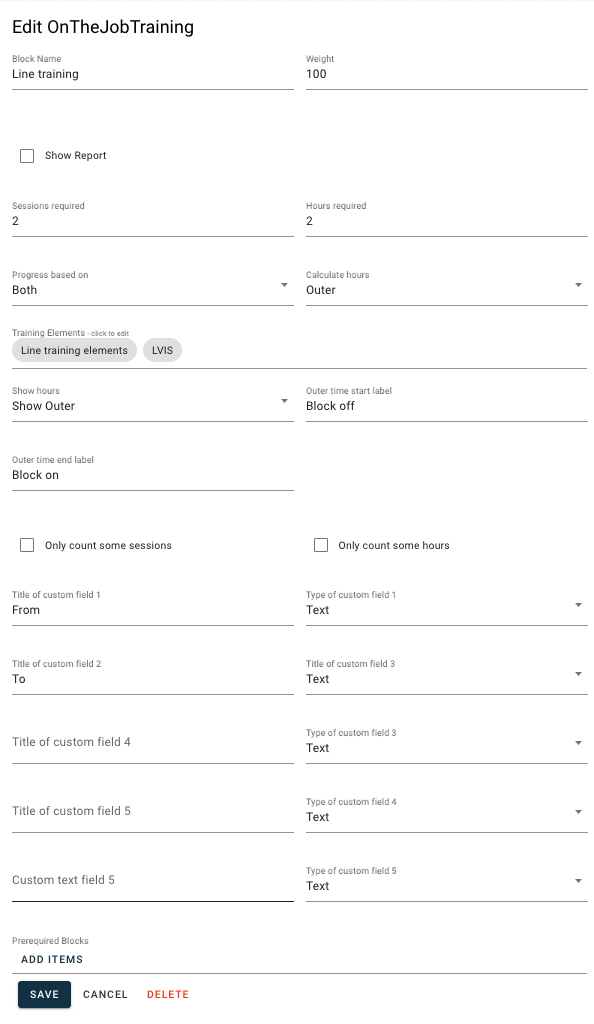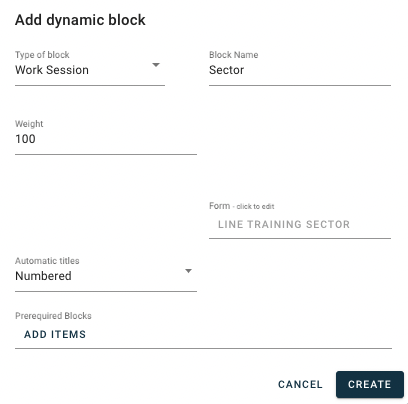Course blocks
A course consists of blocks
When designing a course, you will incorporate a variety of course blocks using the course builder. Each block serves a distinct function. Moreover, certain blocks can be categorized as either Fixed or Dynamic.
Fixed blocks
A fixed block refers to a component that is consistently included in a specific course. This could include, for instance, certain e-learning modules that must be completed or an OPC (Operator Proficiency Check) that needs to be passed before LIFUS (Line Flying Under Supervision). In the course builder, a fixed block is represented by solid lines around the block.
Dynamic blocks
A dynamic block is an optional component that a user can add to a course when utilizing an iPad or web interface. A common application of dynamic blocks is in a LIFUS (Line Flying Under Supervision) program. Here, while a minimum of 10 sectors is mandatory, the trainee might require additional sectors before being prepared for a line check. In such instances, the instructor can add one or more sectors to the LIFUS. Within the course builder, a dynamic block is marked by dashed lines on the block.

Visibility to student and trainers
You can precisely manage which blocks in a course are accessible to students and trainers. For instance, a line training captain might not need access to specific blocks from a ground course that is unrelated to their training. These access settings are initially configured in the course builder during the course creation process. However, they can be individually overridden if necessary through the course manager.
Options for visibility
Depending on the type of block, there are various options available that can be set for both trainers and students.
The basic course level
"Yes" indicates that the course can be viewed by the trainer and/or student. "No" means that the course cannot be viewed by the trainer and/or student.
Module within a course
"Yes" signifies that the trainer or student can view the module. "No" indicates that the trainer or student cannot view the module. "Inherit from course" means that the module will adopt the same visibility settings as the basic settings of the course.
Blocks within a module
- "Yes" means that the trainer or student can view the block.
- "No" implies that the trainer or student cannot view the block.
- "Inherit from parent" indicates that the block will follow the same visibility settings as its parent element.
Block types
When you initiate the creation of a new block, a pop-up will appear, allowing you to choose the type of block you wish to use as well as additional settings for the block.
Block weight
Each block offers the option to assign a specific weight. Adjusting this value allows for certain blocks to have a greater influence on course progress calculations. For instance, if a course contains two blocks, each with a weight of 100, the progress will show as 50% complete upon the completion of one block. Conversely, if one block is assigned a weight of 100 and the other 200, completing the block with a weight of 100 will reflect a progress of 33%. Generally, unless there's a need to specifically regulate progress indication, it's advisable to leave the weight at the default value of 100 for each block.
Pre-required blocks
You can set up certain blocks to be locked until other specified blocks are completed. This feature can be particularly useful in scenarios such as a line check, which cannot be completed until the LIFUS (Line Flying Under Supervision) is finished.

Module
A module functions essentially as a folder, designed to organize and group together various other blocks.
Record block
A record block is typically utilized when a record forms a component of a course. This block will be marked as completed as soon as the associated record is updated within the course timeline. Optionally, a form can be directly used from within the record block to update it. If the form includes additional records, these can also be selected and updated simultaneously through the same form.

Form block
Form blocks within a course are designated to open a specific form that needs to be filled out. A common application of form blocks is in the training component of simulator training.
In the provided example, there are two fixed form blocks and one dynamic form block, which can be utilized if additional training is required.

On The Job Training (OJT):
OJT is implemented to design programs such as a LIFUS (Line Flying Under Supervision). The OJT block specifies the rules and settings for a specific OJT, like LIFUS. The image below illustrates the various options available within an OJT block.

Since this module is primarily utilized for Line Flying Under Supervision (LIFUS) programs, a LIFUS program will be used as an example in the following explanations.
Setting | Details |
Block name | Assign any desired name to the block. |
Show report | Select this option to enable a feature that displays gradings from previous sectors on the iPad. |
Sessions required | Indicate the number of work sessions that are required for this On The Job Training (OJT). |
Hours required | Specify the total number of hours required to complete this On The Job Training (OJT). |
Progress based on | Choose whether the progress calculation for the On The Job Training (OJT) should be based on the number of Sessions, Hours, or a combination of Both. |
Calculate hours | The OJT (On The Job Training) module accommodates up to four different time selections, such as Block Off, Take Off, Landing, and Block On. Within this section, you can choose which of these time fields should be used for calculating the hours. |
Training elements | Incorporate relevant training elements into this On The Job Training (OJT). |
Show hours | In this option, you can choose to display the specific time fields required for your needs. In the aforementioned selection, the options "Show outer" have been chosen, and the fields have been labeled as "Block Off" and "Block On." |
Only count some sessions/hours | This option is useful if, for instance, you want to count only specific types of hours, such as pilot flying hours. In this scenario, select "Only count some hours" and, as an example, enter "PF" in the explanation. This selection will then become available to the instructor during the performance of the work session. |
Work session
Work session blocks are utilized within the structure of the On The Job Training (OJT) block. In this example, the work session is represented by the 'sector-block'.


Related Articles
Courses for trainers
Assigned courses For trainers, managing courses is best accomplished using the iPad app, though most features are also accessible through the web interface. This article will concentrate on the iPad interface for instructors, as it is the recommended ...iPad - Courses
Courses The course module in Crewdox is composed of various course blocks. These courses can be structured in numerous ways. Below, we provide a list of the most commonly used course blocks, along with instructions on how to effectively utilise them. ...Courses for students
See active courses When a course has the setting to be visible to students, the student will be able to follow its own training progress by clicking on "My Courses" in the iPad app navigation. It is not possible to perform any edits in the course ...Courses intro and overview
Courses in Crewdox serve multiple purposes Overview and Compliance They provide instructors and administrators with an overview of the course progress. Courses also ensure compliance by establishing rules for course content, defining visibility, and ...Course manager
Intro The Course Manager is the tool where courses for individual trainees are initiated, monitored, and modified by an administrator. Start a Course In the Course Manager, begin a new course by clicking on "START NEW COURSE." Choose the type of ...